WARGAMESOSD SPI Barbarossa 02 |
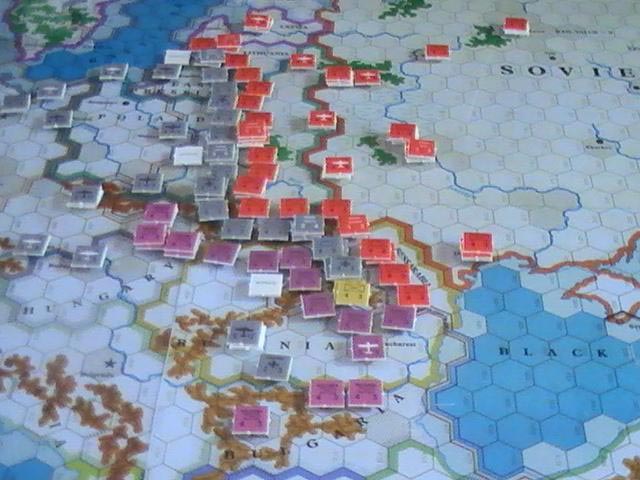 SPI's WWII European Theatre of Operations (ETO) - Scenario 7: Barbarossa Game 2 Set-up, start July 1941, end December 1941 |
| Barbarossa: Setup for Game 2 |
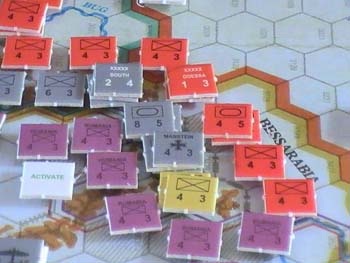 Manstein's Army Group South in Bessarabia south of the Hungarian border with two Hungarian divisions and six Rumanian divisions | 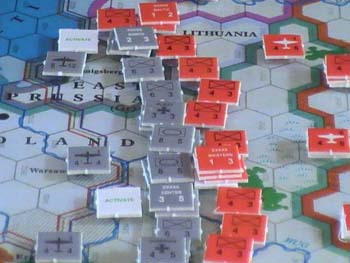 Army Group North in East Prussia. The Soviet Red Army already occupies Polish gains to the South following Stalin's Pact with Hitler |
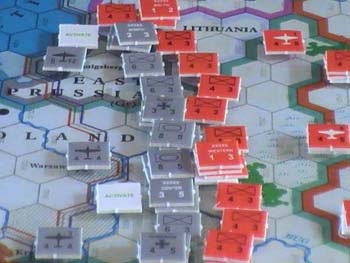 Army Group North, facing the Soviet Western Army. Note Red Army reserves to the east, and also Soviet airfields | 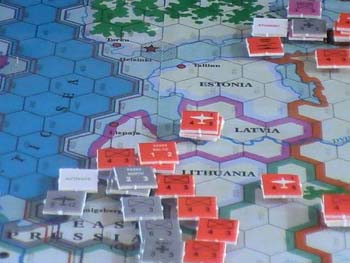 Soviet Baltic Army Group in Lithuania, along with substantive air support to the north in Latvia. Army Group North has been activated ready for attack |
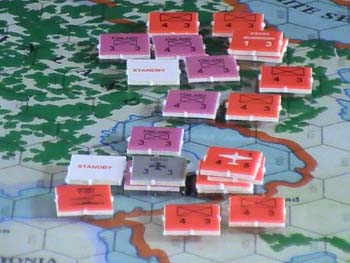 The defence of Leningrad and the isthmus of the Leningradskaja Oblast' as it is now known. Finnish troops form part of the German attacking forces and are on standby in Turn 1 | 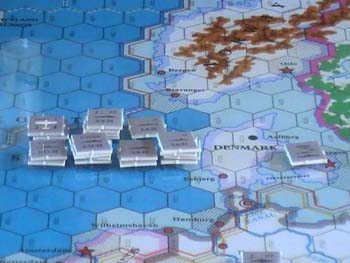 The German Baltic Fleet based in Copenhagen consists of battleships (Lutzow, Scheer, Schleswig-Holstein) & heavy cruisers (Blucher, Hipper, Prinz Eugen) and STP's |
| The
German Offensive in Russia - July 1941 The German offensive opens with three massive army groups (Army Group North, Center and South) of more than 3 million troops. The German player has paid for three offensives in Turn 1 and sets its Rumanian troops in Finland on the Leningradskaja Oblast' isthmus on standby, a small gamble with the troops of Leningrad Military District defense forces on its borders, however, the defence forces are weak in the sense that they will only be able to mount a 1-1 ratio attack, and the Russians have the upper hand if they remain in a defensive role at the opening stages of the battle. The Russians would also recall their disastrous losses two years before when attacking Finland from this isthmus. Note that HQ counters are not requested in the German Order of Battle and therefore need to be added. Four HQ counters added (the three army groups plus Leningrad North - the Finnish Front). Panzer Battles Broadly speaking offensives of 1941 illustrate the wisdom of Jomini's comment, of Napoleon's invasion, that "Russia is a country which is easy to get into, but very difficult to get out of." In the first weeks invasion the German blitzkrieg looked as though it would everything before it. At the outset the Red Air Force-tech- very inferior-was overwhelmed by the Luftwaffe, and the divisions drove far and deep into Russian territory. It will be a question whether a different strategy on Hitler's part have enabled us to force a decision in the critical year of The drive on Moscow, favored by Guderian, and tempo abandoned in August in favour of the conquest of Ukraine, have yielded decisive results if it had been ruthlessly pursued dominating Schwerpunkt of the invasion. Russia might have been paralized by a thrust at the heart of Stalin's power, for the conditions of 1941 were very different from those of 1812. Moscow longer a barbaric metropolis in the middle of a primitive and s state, but was the nexus of Stalin's administrative machine, great industrial area, and-perhaps most important - the centre of the railway system of European Russia. It should not be overlooked, however, that although the German forces were greatly superior in quality, and enjoyed overwhelming air support, yet they suffered from grave disadvantages. The most serious hindrance to our invasion was the primitive nature of the road system, and on this point Liddell Hart makes some pertinent comments: If the Soviet regime had given her [Russia] a road system comparable western countries, she would probably have been overrun in quick time. The German mechanized forces were baulked by the bad roads. But this conclusion has a converse. The Germans lost the chance of victory because they had based their mobility on wheels instead tracks. On these mud-roads the wheeled transport was bogged down when the tanks could move on. Panzer
forces with tracked transport might have overrun Russia's vital centres long before
the autumn, despite the bad roads. A second factor was the very high quality of
the Russian tanks. In 1941 we had nothing comparable with the T34 with its 50
-mm armour, 76-mm high-velocity gun, and relatively high speed with
splendid cross-country performance. These tanks were not thrown into the battle
in large numbers until our spearheads were approaching Moscow; they palyed a great
part in saving the Russian capital. Guderian describes how his 24th Oanzer Corps
was violently attacked to the northeast of Orel on the 11 October 1941, and remarks
significantly: "Numerous Russian T34's went into action and inflicted heavy
losses on the German tanks. Up to this time we had tank superiority, but from
now on the sitation was reversed." |
| The Battle for Mother Russia |
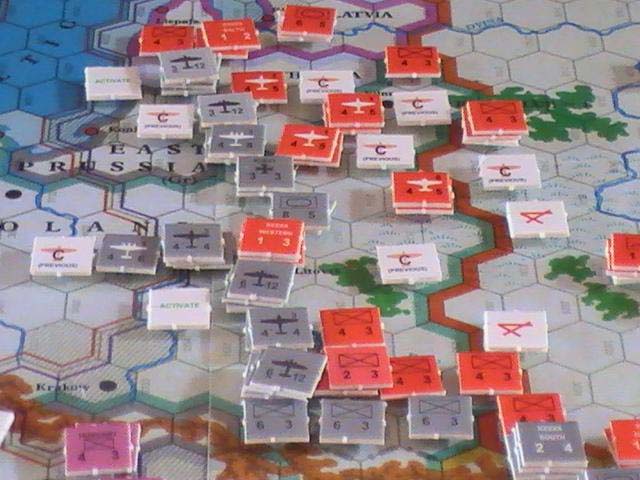 Massive attack formations as German forces spill over the borders in huge numbers. In the centre is the town of Brest-Litovsk, in which the Soviet player has made, for the first two turns, a premium defensive area, along with Lvov in the former Eastern Poland. The air war (Blitzkrieg) prevails with large numbers of Soviet planes meeting the ferocity of the German attack, however, they are overwhelmed. |
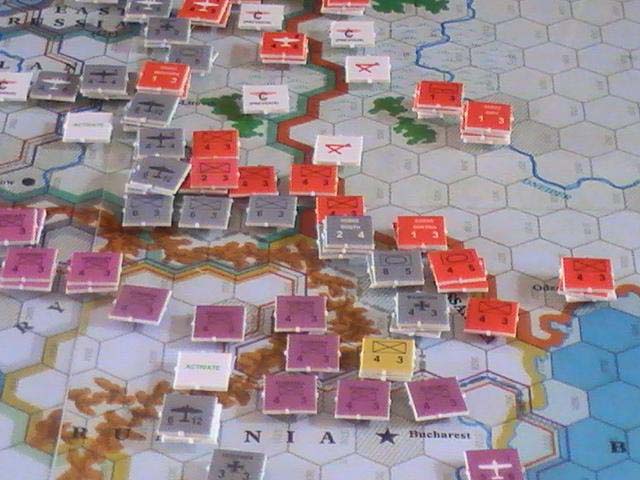 The southern part of the offensive, where the Soviet Odessa Military District force will defend its Black Sea port with distinction. Attacked initially by the main forces of Army Group South, Rumanian and Hungarian forces will drive the attack forward as Army Group South fights its way in a large curve to the northeast to support Army Group Centre in its attack towards Kiev. The River Dneiper will form a strong defensive line for the Red Army. |
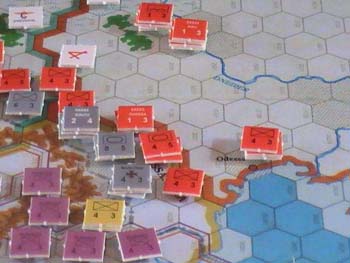 The Odessa Military District and its forces. Odessa is the gateway to the Black Sea and in a sense the whole of Southern Russia and its oilfields. The Soviet player will do well to defend this area as long as possible. | 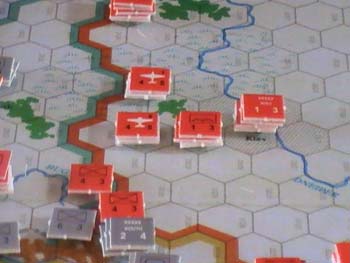 The Kiev Military District with reserves of paratroops, Kiev stands east and west of the Dneiper, whereas Smolensk, further to the north stands to the east only and will be easier to defend |
wargames.wilkey.org.uk |